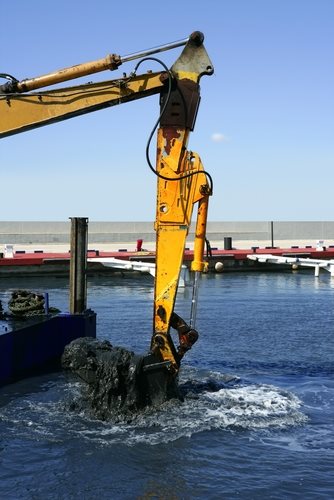Caught in the Act: WalMart Fined $110 Million for Flouting Environmental Laws




On November 19, 2012, the Maine Department of Environmental Protection (DEP) announced it was hiring a Michigan firm and Maine subcontractor to update state mining rules that have not been changed in decades.
The Michigan firm, North Jackson Company, is an environmental and engineering firm located in the Marquette Mineral District. The firm will work with the state DEP over the next 18 months to make changes and provide environmental insight to the mining rules that have not been changed in 20 years. The changes are required by a bipartisan law passed by the state’s 125th Legislature.
The North Jackson Company received a $175,000 contract because they have experience in mineral mining regulations. They have also helped the state of Michigan make changes to their old mining rules. The Maine subcontractor, S.W. Cole Engineering, Inc., with provide consulting in geotechnical engineering, Maine environmental regulations, and landscape information to the Michigan firm.
DEP Commissioner Patricia Aho emphasized that minerals can be recovered in a way that is environmentally sound for the air, land and water—as long as the state’s minding rules are updated.
She also stated: “Our selection of partners with reputations for providing reliable technical information through rigorous science that allows their clients to make sound environmental management decisions demonstrates this process is one we take seriously. We look forward to working with the North Jackson Company and S.W. Cole as we undertake this important work together.”
After the legislature and DEP agreed to update mining rules, a large number of advertisements were sent to members of the National Mining Association and Interstate Mining Compact. The North Jackson Company was selected because they were the most qualified.
The updated rules will address surface water protection and waste rock management as well as ensure that all proposed mining operations prove financially reasonable environmentally and for state citizens.
Commissioner Aho continued: “DEP’s promise is that as this process moves forward, it will be thoughtful and transparent and if mining activity is carried out in Maine as a result of these regulatory updates, it will be done in a responsible, respectful way that helps Maine and its citizens receive the benefits of the resource while also guaranteeing that environmental protections are upheld and subsequent remediation and closure is adequate.”
More information about the updates can be found on the websites of the Maine DEP, North Jackson Company, or S.W. Cole Engineering.
Source: Maine Department of Environmental Protection

New figures show that, energy-saving technologies and a concerted effort in renewables have led to the overall reduction in climate pollution. This drops in climate pollution—even as the U.S. Congress fails to act on climate change in a broad spectrum—brings the United States more than halfway towards President Barack Obama’s goal.
The United States’ carbon dioxide emissions in 2012 fell to their lowest levels since 1994, according to various environmental reports.
Carbon dioxide emissions in the United States fell by 13% in the last five years, due to new energy-saving technologies and a two-fold increase in the practice of renewable energy resources, as confirmed by the Bloomberg New Energy Finance Commission for the Business Council for Sustainable Energy.
This reduction in climate pollution brings the United States more than halfway towards President Obama’s target of reducing emissions by 17% from 2005 levels over the next decade.
By the end of 2012, the United States’ emissions of carbon dioxide and other greenhouse gases had fallen nearly 11% from the 2005 levels. This drop puts President Barack Obama in a better position to defend his environmental policies and achievements, which often go overlooked in the bitter realm of climate science. Moreover, such statistics may bolster America’s standing with global climate regulations.
Lisa Jacobson, acting President of the Business Council for Sustainable Energy, said these findings exposed the conservative argument that acting on climate change would hinder the economy—carbon emissions are declining while GDP is rising.
The dramatic decrease in Carbon emissions is attributed to the country’s shift in energy production—Coal fell to 18% in 2012 from 22.5% in 2007 of the nation’s energy mix, and oil use also declined.
Thanks to fracking, natural gas production filled the majority of this gape—the United States received 31% of its electricity from gas-fired plants in 2012.
The report also noted that steadily expanding installations of solar, wind, hydro and geothermal energies have led to the significant drop in Carbon emissions. Renewables represented the largest source of new growth last year, reaching $44 billion.
Over this timeframe, total energy use fell by 6.4% since 2007. The bulk of emissions cut were largely due to installing more efficient cooling and heating systems in commercial locations. Other cuts in emissions came from transport, as 488,000 Americans purchased plug-in or hybrid vehicles.
This mix of energy sources proves that the economy can grow as our reliance on carbon-emitting gases declines.

On November 20, 2012, the Department of Energy (DOE) announced it was awarding support for the design and licensing of small modular reactors with the United States. The strategy is parallel with the Obama Administration’s strategy to access every possible source of energy in the United States.
The funding was announced in March of 2012, and the DOE has just announced the recipient of the award. The project is led by Babcock & Wilcox (B&W) along with the Tennessee Valley Authority and Bechtel. If strategies stay the same, the DOE plans to solicit other companies and manufacturers to focus on developing small modular reactor designs and operations.
The investment from the DOE to B&W will help the company receive Nuclear Regulatory Commission licensing requirements and begin commercial operations by 2022. The small modular reactor project will first occur in Tennessee, but the DOE plans to help operations in Indiana, Maryland, North Carolina, Ohio, Pennsylvania, and Virginia. All of the projects will help U.S. utilities receive power from low carbon sources while increasing export opportunities and U.S. dominance in the world energy market.
Secretary Chu stated: “The Obama Administration continues to believe that low-carbon nuclear energy has an important role to play in America’s energy future. Restarting the nation’s nuclear industry and advancing small modular reactor technologies will help create new jobs and export opportunities for American workers and businesses, and ensure we continue to take an all-of-the-above approach to American energy production.”
The recent projects stands as the first-ever government investment in the design, implementation, and licensing of small modular reactors. The DOE will invest in about half of the project’s total cost through a five-year cost-share agreement. Babcock & Wilcox will provide the other half of investment, but the specific amounts toward the project are still being decided by the DOE and B&W.
Small modular reactors are about one-third the size of traditional nuclear power plants. The smaller designs increase safety and offer more economically benefits over large nuclear plants. Also, the small modular reactors can be manufactured at factories then transported to the sites were they can basically be plugged in. The designs decreased capitol costs and construction costs for nuclear energy.
Small modular reactors have other benefits as well. Large reactors cannot be used on some small grids, while small modular reactors can provide power to small grids in a cost-effective way. The reactors allow greater flexibility for utilities as demands grow.
Source: Department of Energy


On November 23, 2012, the UK Department of Energy and Climate Change (DECC) reached a landmark decision to increase investor confidence and generate 250,000 jobs in the energy sector. The decision, called the Electricity Market Reform (EMR) in the Energy Bill, will address electricity demands through low-carbon technologies in the United Kingdom as about 20 percent of the country’s generating capacity from conventional, carbon-based sources decrease over the next decade.
The EMR hopes to give confidence to certain investors and create government contracts for about £110 billion in investments.
The sections of the Energy Bill allow the following:
· Create a government owned-company to give investors more confidence while investing in long-term contracts called “Contracts for Difference” for low-carbon electricity projects
· Allows auctions for generating capacity from 2014 for the winter of 2018/2019 to make sure peak demand is addressed
· Provides confidence to gas investors to make sure energy demands are addressed (Gas Generation Strategy published with Chancellor’s Autumn Statement)
· Sets a target range for reducing carbon emissions by 2030
The UK’s Climate Change Committee will make suggestions in 2016 during the Fifth Carbon Budget to make sure target ranges are reached by 2030. Until 2016, the government is providing tips to National Grid for different ways to reach lowered emissions ranges by 2030 and even reach target ranges by 2050 in the most economical way. A sample approach for the UK 2050 carbon target is explained in the Fourth Carbon Budget.
Edward Davey, the Energy and Climate Secretary, stated: “They [the Coalition Agreement decisions] will allow us to meet our legally binding carbon reduction and renewable energy obligations and will bring on the investment required to keep the lights on and bills affordable for consumers.”
The decarbonization targets were set by the Climate Change Act of 2008. Together with the decarbonization targets and government-issued contracts, about £9.8 billion in 2020 prices is set aside in the Levy Control Framework. The budgeted investment by the government will decrease dependency on gas imports by establishing renewable energy. By 2020, about 30 percent of the UK’s energy will come from renewables—compared to 11 percent in 2012. The investment will also ensure power from new nuclear energy and commercialized carbon capture.
Davey continued, “The decisions we’ve reached are true to the Coalition Agreement, they mean we can introduce the Energy Bill next week and have essential electricity market reforms up and running by 2014 as planned.”
The shift in public spending by the government, referred to as the Levy Control Framework (LCF), is the responsibility of the Treasury. The spending meets energy and climate goals in line with economic recovery and the least impact on utility bills for consumers.
The spending does not include the ECO or the Warm Homes Discount in the UK. These programs have separate spending limits for 2015.
Source: Department of Energy & Climate Change


On November 13, 2012, the Environmental Protection Agency (EPA) reported that the third consecutive season of dredging on the Hudson River was completed. A total of 1.3 million cubic yards of sediment containing PCBs has been removed from the Hudson River so far.
The dredging began on May 9, 2012 after General Electric (with oversight form the EPA) removed 650,000 cubic yards of contaminated sediment south of Fort Edward, New York. The EPA is now half way to its goal of removing 2.65 million cubic yards of polluted sediment from 40 miles of the upper Hudson River.
The EPA reports that approximately 1.3 million pounds of PCBs went into the Hudson River after they leaked from two General Electric manufacturing plants in Fort Edward and Hudson Falls.
The EPA set strict standards during General Electric’s dredging. The company could not allow more than 2 percent of the dredged PCB-contaminated sediment to stir and become suspended in the water. The first series of measurements were conducted in Waterford. Additionally, the EPA did not allow the company to suspend more than 1 percent of the contaminated sediment by the time the water reached Waterford. Waterford is the farthest monitoring station downstream on the Hudson River.
The company fulfilled a goal of letting no more than 11 percent of the project undergo capping as well. General Electric’s seasonal cleanup only accounted for 5 percent capping in the contaminated area besides capping that could not be prevented.
The dredged sediment is stored at the Fort Edward processing facility and shipped to authorized disposal facilities in other states. The material will continue to be transported out-of-state by train until all of the sediment is removed from the Fort Edward processing plant.
Source: U.S. Environmental Protection Agency

On November 29, 2012, the US Attorney’s Office for the District of Oregon announced that Rebecca Jeanette Rubin from Canada surrendered at the border in Blaine, Washington. She faces conspiracy, federal arson, and destructive device charges throughout California, Colorado, and Oregon. Her crimes are part of the largest eco-terrorism case in U.S. history, and she remained an international fugitive for more than 10 years.
Rubin is charged with being part of a group that caused 20 arsons in five western states from 1996 to 2001. The group was made of self-proclaimed members of the Earth Liberation Front (ELF) and the Animal Liberation Front (ALF). The group attempted to cause environmental damage and fight against government, businesses, and the general public by engaging in violence, mass destruction, intimidation, and other forms of violent retaliation.
Rubin faces state charges in Oregon for the November 30, 1997 and December 22, 1998 arsons at the U.S. Bureau of Land Management Wild Horse and Burro Facility near the town of Burns in Harney County and the U.S. Forest Industries Inc offices in Medford. She also faces a state charge in California for arson and using a destructive device at the BLM Litchfield Wild Horse and Burro Corrals on October 15, 2001 around Susanville, California.
The eight federal charges are for an arson that destroyed the Two Elk Lodge and surrounding buildings in Eagle County, Colorado on November 30, 1997.
A count of arson carries a maximum penalty of 20 years in prison and a mandatory minimum of five years. Using a destructive device carries a mandatory consecutive sentence of 30 years in prison, and conspiracy carries five years in prison.
Since August 2007, 10 defendants in the same case have received sentences from 37 months to 156 months in prison.
Two of the defendants are still fugitives: Joseph Mahmoud Dibee and Josephine Sunshine Overaker.
Source: Federal Bureau of Investigation